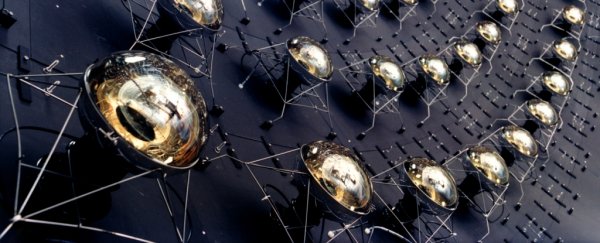A neutrino detector has just made an incredible detection: far more of the mysterious particles than they expected. And the best explanation for this mysterious abundance is the existence of a hypothetical type of neutrino, called the "sterile" neutrino.
The finding, made at Fermilab's MiniBooNE, replicates a result from decades ago. Back in the 90s, the Liquid Scintillator Neutrino Detector (LSND) experiment at Los Alamos, New Mexico also found an excess of neutrinos - and the most popular explanation for the anomaly was the existence of sterile neutrinos.
But there's a problem: many other neutrino experiments in the intervening years have failed to replicate such an anomaly. So, what's going on here?
Neutrinos are among the most abundant particles in the Universe, but they're very hard to detect. They're similar to electrons, but they have no electrical charge and very small mass, so they interact very little with normal matter.
They come in three flavours - electron, muon and tau, and the latter two are associated with the heavier electrons of the same names.
Then there's the hypothetical fourth, the sterile neutrino. Such a neutrino wouldn't interact with matter as per the Standard Model of particle physics, except maybe through gravity.
If sterile neutrinos exist, they would break the Standard Model, and change particle physics forever. These particles have even been proposed as a possible candidate for what dark matter could be made of.
But this lack of interaction also means sterile neutrinos can't be directly detected with a neutrino experiment like LSND or MiniBooNE, which use photomultiplier tubes to detect the minute flashes of light produced by neutrino interactions.
However, an excess of neutrinos hints at the particle's existence, since - theoretically - they can mix with normal neutrinos and change the amplitude of oscillation.
Earlier MiniBooNE results turned up an excess of electron neutrinos and antineutrinos, which had physicists intrigued, but sceptical; the new result is much more pronounced.
The experiment was set up to replicate an earlier experiment, which found that neutrinos can change flavour. The researchers fired beams of muon neutrinos and antineutrinos into MiniBooNE's oil-filled tank to detect the light flashes that result from an interaction between antineutrinos and electron neutrinos.
They observed 2,437 events - which was around 460 more than they expected.
This makes it less likely that, as other physicists have proposed, the LSND result was the result of a miscalculation.
But there have still been other experiments that have not been able to replicate the result, including one at MiniBooNE itself in 2007.
Most damning was the result from the IceCube neutrino detector at the South Pole in 2016. After analysing 100,000 neutrino events, observed over the span of a decade, physicists announced they had not managed to make a detection consistent with the existence of sterile neutrinos.
This doesn't mean they don't exist. But it doesn't mean they do, either; other particles, for instance, could have caused the LSND and MiniBooNE results.
So far these latest results are only published on the pre-print server arXiv, so while there hasn't been any peer review yet, the physics community is now digging in to figure out more.
We know that the results exist, but not what caused them - or why they're so tricky to replicate. But it's certain we'll be hearing more about sterile neutrinos before long.
The paper is available on the pre-print resource arXiv.
